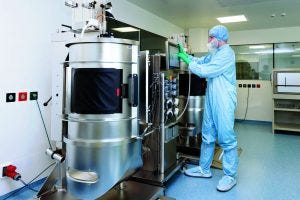Voices of Biotech
Podcast: MilliporeSigma says education vital to creating unbreakable chain for sustainability
MilliporeSigma discusses the importance of people, education, and the benefits of embracing discomfort to bolster sustainability efforts.
Sponsored by Yposkesi
 As a full-service contract development and manufacturing organization (CDMO) specializing in gene therapy development, Yposkesi produces recombinant adenoassociated virus (AAV) and lentivirus (LV) vectors using adherent-based and suspension-adapted cell expression platforms. Alain Lamproye joined the company as chief executive officer (CEO) in January 2017, having served previously as president of the biopharmaceutical business unit of Novasep (2012–2017) and as CEO of Henogen, its subsidiary dedicated to gene therapy. He has held managerial positions in pharmaceutical operations at Merck Serono (including site director in Billerica, MA) and Eurogentec (as GMP production director). Lamproye holds an MS in biology from the University of Liège in Belgium.
As a full-service contract development and manufacturing organization (CDMO) specializing in gene therapy development, Yposkesi produces recombinant adenoassociated virus (AAV) and lentivirus (LV) vectors using adherent-based and suspension-adapted cell expression platforms. Alain Lamproye joined the company as chief executive officer (CEO) in January 2017, having served previously as president of the biopharmaceutical business unit of Novasep (2012–2017) and as CEO of Henogen, its subsidiary dedicated to gene therapy. He has held managerial positions in pharmaceutical operations at Merck Serono (including site director in Billerica, MA) and Eurogentec (as GMP production director). Lamproye holds an MS in biology from the University of Liège in Belgium.
AAV Vector Production
Scale-Up Issues: Cost-effectiveness of large-scale manufacturing for viral vectors is a key challenge in gene therapy development. How are your development teams working to improve productivity of AAV vector production? And what can you tell us about your special transfecting agent and high-producing cell line?
At Yposkesi, innovation and development have had high priority. The development teams are divided into centers for industrial development, analytical expertise, process development, and vector proving, with a combined staff of more than 35 people. Even though adherent-growing cells provide better productivity than suspension cell-based processes, the latter are scalable. That’s why Yposkesi is developing these systems.
We aim to increase rAAV production by improving plasmids for transfection and evaluating different production processes based on suspension to identify new options for large-scale manufacturing of rAAV-based vectors. Yposkesi offers two cell-substrate options: a HEK293 cell line and a HEK293T YPK+ cell line. The latter is a high-productivity clone isolated from a parental HEK293T cell bank. Cell expansion begins in suspension in shake-flasks before transfer to a single-use-bioreactor with animal-free media. Currently, cell expansion is scaled up to one or two 200-L bioreactors, but we intend to implement a 1,000-L bioreactor in our new production facility by 2022.
One current limitation in gene therapy is improving the yield of functional viral vectors to reduce overall production costs. Yposkesi is tackling the major bottleneck of efficient delivery of plasmid DNA into mammalian producer cell lines for upstream viral production. We do that by carrying out triple transfection using a proprietary “modified PEI” process based on the method of French company Polytheragène.
Lentiviral Production
Suspension Cell Culture: For LV vectors, you have developed a large-scale suspension process. What cell line do you use, and what scales are you working with? How did your innovation team go about development of this process? Did they work with any collaborators?
Globally standard LV vectors are made using a third-generation production system that relies on transient transfection of HEK293T cells. This method can generate high-titer LVs without contamination by replication-competent LVs. This production system is adherent and serum-dependent because of the HEK293T cell line used. Clinical-grade LV production is limited because it requires multiple-stack plastic tissue culture vessels — e.g., 10-stack Nunc Cell Factory systems from Thermo Fisher Scientific. That increases the handling, personnel and consumables costs, and production time required.
Yposkesi spun out as a CDMO from Généthon, the world-renowned charity-funded research and development (R&D) organization for design and development of gene therapies for rare diseases. Process development teams at both Yposkesi and Généthon worked together to develop a suspension process for LV vectors.
Cell suspension is initiated in shake flasks before cultures are transferred to single-use bioreactors. Our processes have been developed to a scale of two 200-L bioreactors. Cell expansion takes place in media free of animal components. Transfection is performed using polyethylenimine (PEI) or a proprietary optimized PEI. After 48 hours and benzonase treatment, the product undergoes purification steps as outlined below. Fill and finish operations also are performed on-line to prevent loss of product from freezing.
Sterile Filtration: One key step in downstream processing involves separating viral particles from lysed cellular debris. An associated challenge is to produce a clarified filtrate without retaining virus particles. A 2018 BPI article from MilliporeSigma addressed filter-based clarification of viral vectors and vaccines (1). What approach does your company use?
After production, bulk harvest material is processed to purify viral vectors. Following upstream production and cell lysis, a clarification step typically starts the purification process. For large-scale production, filtration is the most common technique. Filtration-based technologies have gained prominence in vector clarification with increasing implementation of single-use technologies. This unit operation is critical because it strongly affects product recovery and subsequent downstream purification.
Filtration at Yposkesi downstream processing is performed in multiple steps. The first step after lysis uses a 0.45-µm filter, and final filtration uses a 0.2-µm filter. To ensure that the risk of microbiological contamination is low during this process, a thorough risk-assessed procedure includes operator qualification for manufacturing operations in aseptic conditions, standard operating procedures (SOPs) describing the manufacturing operations, control of raw materials, filtration of all buffer solutions, and equipment and cleanroom qualification. Filter-integrity testing is performed before and after operations, and pressures are monitored during the filtration process.
Product Characterization
How does Yposkesi get involved in product characterization? What does it take to characterize an advanced-therapy product fully?
Yposkesi works to optimize transduction processes for advanced therapies (e.g., CD34+ hematopoietic and T cells) using robotic automation, closed systems, cryostorage, and development of analytical methods for product characterization (identity, purity, and potency assays).
Analytics for Measuring Titer Values: Detection of vector copy numbers (VCNs) in target cells permits assessment of the therapeutic window for integrative vectors related to biological potency. Currently, this is achieved with quantitative polymerase chain reaction (qPCR) to measure proviral DNA copy numbers per host-cell genome. However, the technique is sensitive to contamination and requires the production of standard curves from plasmid-bearing vectors and genomic sequences.
Droplet digital polymerase chain reaction (ddPCR) is a novel molecular biology technique from Bio-Rad Laboratories that provides absolute quantification of target nucleic acids without needing an external calibrator or multiple replications. This method also can be applied to determination of LV infectious titers and definition of final-product purity by confirming the elimination of contaminants (vectors and plasmid DNA) after cell transduction. At Yposkesi, we are developing procedures to incorporate ddPCR in quality control (QC) techniques and demonstrating to our clients the reproducibility of the method across different time points, technicians, and laboratories.
 Full and Empty Capsids: Empty capsids have different densities from those of full capsids because of the absence of nucleic-acid material. So they can be separated by gradient centrifugation. But empty AAV capsids could enhance gene transfer by mitigating preexisting humoral immunity to the viruses. Some researchers have hypothesized that the ratio of full to empty virus capsids is important in gene-therapy product efficacy and quality. Can you elaborate on this and how it affects Yposkesi’s work?
Full and Empty Capsids: Empty capsids have different densities from those of full capsids because of the absence of nucleic-acid material. So they can be separated by gradient centrifugation. But empty AAV capsids could enhance gene transfer by mitigating preexisting humoral immunity to the viruses. Some researchers have hypothesized that the ratio of full to empty virus capsids is important in gene-therapy product efficacy and quality. Can you elaborate on this and how it affects Yposkesi’s work?
We are having many discussions with our clients (product developers who are sponsors of clinical trials) on their understanding of the issues with full and empty capsids. In one sense this is a problem of comparability in production processes. Clients come with a laboratory-scale process that produces vectors at small scale using adherent cells. The Yposkesi process development team then creates a suspension process for production of the same vectors, but the ratio of empty to full capsids often will be different from that obtained by the product developers. That is a consequence of the process change.
Our process developers are working with clinical-trial sponsors to find optimum ratios for vector doses to be provided to patients. Our development teams are looking at different upstream and downstream technologies to provide the required ratios. Options include further optimization of the production process to reduce empty capsids using an additional chromatography step. Other options for customizing the empty/full capsid ratio includes the possibility of removing empty capsids while processing and then adding them back to the desired ratio. Our Centre for Analytical Expertise is qualifying new techniques to measure the full and empty capsids. Methods include analytical ultracentrifugation (in-house) and cryotransmission electron microscopy (subcontracted) and developing ultrahigh-performance liquid chromatography approaches (2).
References
1 Cherradi Y, et al. Filter-Based Clarification of Viral Vaccines and Vectors. BioProcess Int. 16(4) 2018: 48–53; https://bioprocessintl.com/downstream-processing/filtration/filter-based-clarification-of-viral-vaccines-and-vectors.
2 Challener CA. Mapping a Route for Cell and Gene Therapy Process Development. BioPharm Int. 33(1) 2020: 25–29, 32; www.biopharminternational.com/mapping-route-cell-and-gene-therapy-process-development.
For more information, please contact vice president of US sales and marketing Patrick Lansky ([email protected]) or chief commercial and marketing officer Patricia Collet ([email protected]) for Europe or the Asia–Pacific region.
You May Also Like